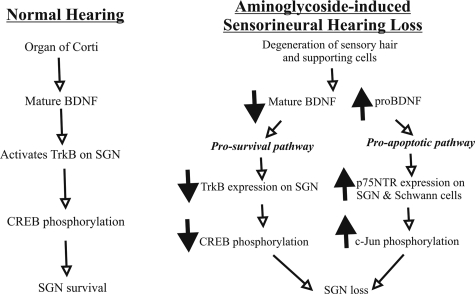Figure 8-6921.
Schematic summary of the different patterns of gene regulation in the cochlea after aminoglycoside-induced sensorineural hearing loss. In a normal hearing cochlea (left panel), the hair and supporting cells of the organ of Corti produce target-derived mature BDNF to activate TrkB receptors on SGN triggering phosphorylation of CREB and consequently SGN survival. After aminoglycoside administration (right panel), sensory cells of the organ of Corti progressively degenerate, reducing the availability of mature BDNF and inducing a decline of TrkB expression and CREB phosphorylation in SGN. In contrast, p75NTR expression and c-Jun phosphorylation are up-regulated in SGN, suggesting an activation of apoptotic pathways when pro-survival neurotrophic support is diminished. An increase in the expression of a truncated pro-BDNF isoform in aminoglycoside-deafened cochleae also indicates defects in BDNF processing, which may contribute to SGN loss. Changes in gene expression (downward, down-regulation; upward, up-regulation) are indicated by the bold arrows.

